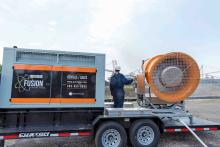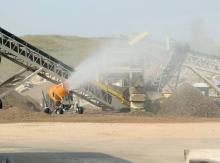There are many challenges being faced in quarrying and aggregate production, with new equipment and techniques being developed. Becoming more prevalent in virtually all operations is the development of clean air/dust control technology. This encompasses many innovations, including new low-emission engines from the likes of Caterpillar, Volvo CE and Deutz (amongst others), integrated dust control systems on breakers, screens and crushers, as well as equipment that can be powered by either generators or mains electricity. Many manufacturers are now implementing clean air solutions in the working environment, not just as an afterthought, but as a mainstream activity. In fact, if one good thing has come from the coronavirus outbreak, it has been the increased importance given to ‘new’ air cleaning systems. These are now not only helping to protect against the pandemic but are also helping to produce a cleaner working environment which is increasingly seen as vital in quarrying.
Dealing with airborne particles
In recent years, construction and quarrying equipment manufacturers have focused on mitigating the effects of airborne microparticles. A commonly accepted practice in Europe (EU legislation was introduced in 2016), North America is now also experiencing a significant move towards new dust control/clean air equipment due to the OSHA regulations on silica dust control. European and American legislation is affecting the industry in many ways. Still, it places the onus on companies to protect their workers from any prolonged and concentrated exposure to particles such as airborne silica. This is due to the significant possibility of those exposed to such airborne particles developing serious health problems such as silicosis, chronic respiratory issues, lung cancer and kidney disease.
Due to the small size of airborne particle emissions, as well as other dusts resulting from mineral excavations and processing, the material can penetrate the body’s natural defences (mucus membranes, cilia, etc.), reaching deep into the lungs. Invisible to the naked eye and able to travel long distances on ambient air currents, the particles present an unseen danger to workers who might then lower their guard and remove protective masks, putting themselves at risk of contracting serious conditions over time. Silicosis itself is a chronic and incurable disease that affects millions of workers across the world (although regulations have been tightening for many years) in a wide variety of industries. Without proper protection, workers with long-term exposure can experience a build-up of dust in their lungs, restricting lung capacity.

With this in mind, not only does the EU and OSHA legislation require regular monitoring by the employer, but it also sets personal exposure limits and suggests engineering controls and particulate isolation rather than putting the onus of responsibility entirely on the employee via respirator use. By doing this, regulators also limit fugitive dust emissions from leaving the site line and exposing the wider public. The end result has been the development of solutions and systems that are protecting workers, members of the public and the environment from harmful emissions.
Additionally, many of these systems have proven to be highly effective in helping combat and disinfect airborne coronavirus particles (as of the 8 July 2020, the WHO advised of the dangers of airborne particles with regard to COVID-19.
Atomised water-mist dust suppression systems
There are now available a variety of atomised water-mist dust suppression systems from a cross-section of manufacturers. One such company is BossTek through its DustBoss line of atomised mist cannons. These use high-pressure water driven to a circular manifold at the end of a specialised cylindrical barrel, with an industrial fan located at the rear. As the unit oscillates, the fan directs air through the cone-shaped cannon. It propels millions of tiny droplets, approximately the same size as the dust particles, in a long cone covering an area of up to five football fields in size. The equipment has been used successfully for many years, proving its worth on demolition, construction, quarrying, tunnelling and civil engineers sites.

For outdoor isolation of particle emissions for stack-out conveyors and chutes (such as found in quarries and aggregate plants) where the cargo stream is exposed to open-air currents, the system works by using point-source suppression such as non-mechanical misting rings and spray bars. A misting ring encloses the stream in a curtain of atomised mist, preventing dust from migrating. Open-air discharge resulting in dusty blowback from impact, e.g. when vehicles load into a hopper or from a conveyor discharging into a transfer chute, can be suppressed by combining rings and spray bars to create a dust barrier. For hydrophobic materials such as coal, dosing pumps attached to both the mechanical and non-mechanical units are able to apply dust-suppressing surfactants and crusting agents. The sprayed surfactant agents reduce the surface tension of water, improving its ability to wet surfaces and form fine droplets that reduce dust emissions.
Another leading company is Brokk which unveiled the Brokk ‘Atomized Water Mist System’ during CONEXPO-CON/AGG 2020. The new dust suppression system produces atomised fog that effectively binds dust particles in the air while also providing ground-level dust suppression. Additionally, the mist dissipates, rather than forming puddles, for a safer, cleaner job site. “Safety has always been paramount for Brokk, which is why, for more than 40years, our engineers have constantly produced machines, attachments and technologies that allow operators to step away from the most dangerous and backbreaking operations,” said Martin Krupicka, president and CEO of the Brokk Group. “However, silica dust remained a concern because it is difficult to contain. Previous dust suppression methods helped, but we wanted to find a more efficient solution that optimised safety without the mess.”
Meeting safety regulations has taken several forms with some contractors choosing to use spray systems, hoses, sprinklers, and water trucks to combat dust. However, these interventions are often inefficient and, in some cases, ineffective. The problem stems from the size of the water droplets, which are much larger than the silica dust they are meant to trap. Hose and water-truck spray methods are the most inefficient since they produce the largest droplets, but even smaller onboard systems produce large droplets that can deflect particles, which can then be breathed in.
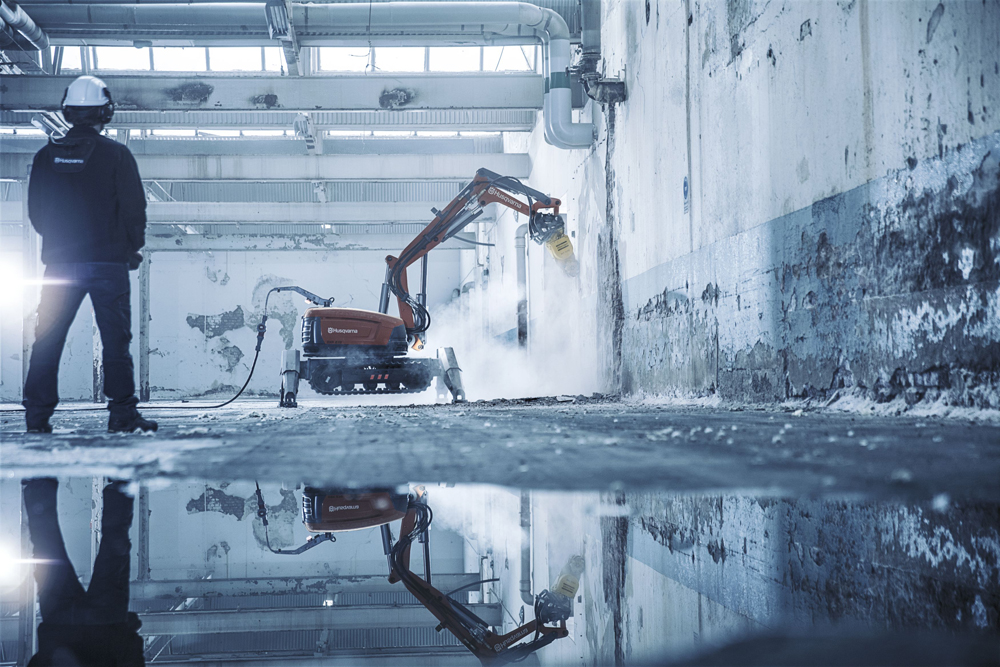
Since many airborne particles such as silica dust, are more likely to bond with water droplets of similar size, Brokk engineered its dust suppression system to produce 10micron mist droplets. This creates a fog of atomised water, as with the BossTek system, that captures dust particles in the air and spreads along the ground for optimal dust suppression. The method is incorporated into the tool mounting instead of the tool itself as found in other systems allowing operators to provide dust protection with any Brokk attachment, including breakers, concrete crushers and drum cutters. A hydraulic water pump is attached to the machine and can be fed with a freshwater hose or water tank.
In a similar vein, some years ago in Sweden, a new dust extraction technique for the construction industry was launched. It offered a very efficient way to control dust particles in the air by ionising the air in the workplace. The ionised air makes the dust particles lump together, and through increased weight, the particles fall to the floor, making it easy for them to be sucked up by a dust extractor. The company Renluftsteknik AB has used the technique in its Oxysan series of air cleaners, the range having been upgraded recently, with the industrial ionisers today covering a workplace area from 20m2 to 400m2. The technology is 100% ozone free, and eliminates not only hazardous dust but also odours and bacteria, making it useful in many types of environments. The air cleaners now provide longer throwing distances and more ionisation which, according to Renluftsteknik, make the particles sink to the floor faster.
Other highly effective systems
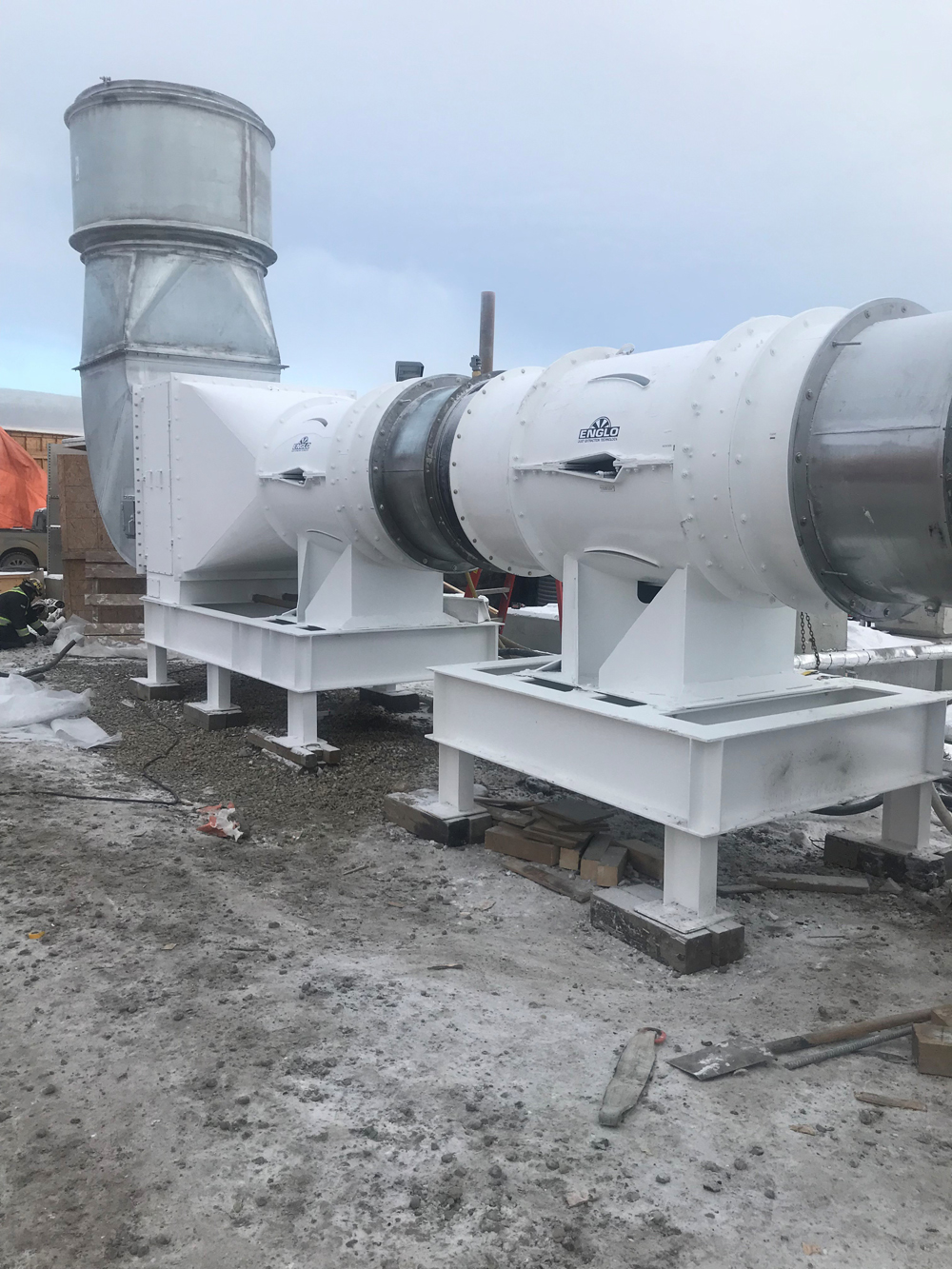
US-based JH Fletcher has undertaken massive strides towards the development and application of clean-air technology, specifically for its tunnelling equipment, as well as machinery used in quarrying and mining and general construction. Currently, the company offers enclosed operator compartments as an option on all its drilling jumbos, with most being available with an inbuilt air conditioning/heater systems for mobile equipment. The company’s air conditioning/heater system has been purpose-designed for enclosed operator cabs, with high-efficiency filters for both recirculated air and the make-up air. The jumbos may also be equipped with an exhaust purifier, as well as Tier IV engine options.
The company also manufactures a mobile dry scrubber, which is an independent vehicle, designed to filter air and direct it back out into the main air stream. For its roof-bolting equipment, JH Fletcher offers operator air canopies, with air being pulled through a fan, filtered, and then pushed down over the breathing zone of the person working beneath the canopy. Atlas Copco’s Epiroc division and Sandvik Mining and Rock Technology have both ensured that their equipment is also able to protect operators from dust and other emissions through the use of similar developments.
The increasing demand for clean air/dust control technology has also seen developments from lesser-known companies such as Engart Global. This manufacturer focuses on dust extraction equipment and dust reduction solutions like its wet dust extractor unit. This enables users to maintain the proper air volumes required to alleviate fumes from equipment and to control the dust emissions generated. Such developments result not only in compliance with increasingly stringent workplace regulations but also increased productivity through better visibility and generally improved working conditions.
Dynaset has also developed its own ‘HPW-Dust’ high-pressure dust suppression system, which is a compact and eco-friendly system designed to be easily installed onto any mobile machine such as excavators, screeners and crushers. It uses the hydraulic power of the machine to convert water to high-pressure water mist. According to Dynaset, the system provides better dust suppression performance with a smaller water droplet size than traditional low-pressure dust suppression systems. The company believes that a smaller droplet size also binds more dust particles with minimal amounts of water. The system is integrated onto the base machine’s attachment head, or wherever the dust suppression is needed for maximum effect. It has a large variety of nozzles and pumps for configurations to fit all vehicles and dust suppression applications. It comes with a power washing pistol for power washing applications and can also be equipped with a ‘Double Dust’ boosting system that multiplies the dust suppression power.
As was seen with the latest Brokk development, robotic advances are now also providing clean air/dust control solutions. Robotics equipment can undertake tasks that may negatively affect humans but can also minimise or remove contaminated air. Swedish company Husqvarna seems to be at the forefront of these developments, with a dust reduction accessory being available for all its DXR robots. The accessory supplies water to the tool (in this case Atlas Copco breakers) that is sufficient to bind the airborne dust, contributing to a better working environment and reducing the risk of the operator or others nearby of breathing harmful dust particles. The accessory also provides a more efficient and economical way of working by eliminating auxiliary equipment or the need for extra staff to engage with airborne dust. As well as the environmental benefits, the dust reduction kit has a unique and effective water management system.
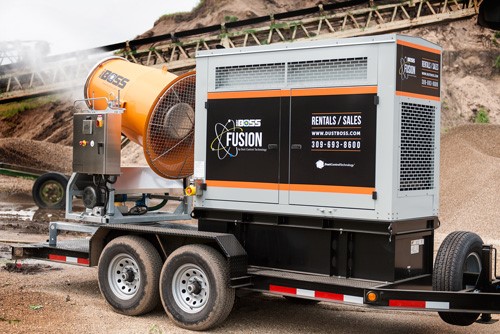
The latter has been developed as one of the best ways to control dust is by using water, if possible, using enough water while wet cutting/drilling to bind the dust directly at the source. This does, however, lead to the production of slurry (excavated rock and water) and to remove this Husqvarna has developed a slurry collector that may be attached to a specially developed slurry vac. In addition, the company has also developed a line of dust extractors designed to meet strict emission regulations.
Fighting the coronavirus
In 2020, as a direct result of the effects of the coronavirus pandemic, a number of systems have been developed to help mitigate and deal with the effects of the virus. What is interesting is that these systems also have a direct application in dealing with airborne dust particles resulting from mineral excavations and aggregates production. WLP s.r.l., a dust control specialist based in Northern Italy, offers a decontamination system that can considerably reduce the diffusion of the virus. WLP began to design and build decontamination systems some four years ago, following a 6.2 Richter-scale earthquake in Central Italy on 24 August 2016. A great deal of livestock was killed by collapsing stables, causing a real threat of an epidemic. The situation was quickly resolved at the time, but it did prompt the WLP engineering team to look into decontamination issues. Two years later, the Italian manufacturer came up with the NCA (no contaminated area) solution. Designed to hinder the proliferation of dangerous bact
eria with the aid of non-toxic additives, a self-contained NCA system consists of an electric generator set, a large volume tank with decontamination solution and a spraying cannon or nebuliser.

Buffalo Turbine introduced is own ‘District Disinfector’ series. This is the latest in its line of sprayers designed to aid in the fight against the COVID-19 coronavirus. The new easy-to-deploy self-contained sprayer may be used with any truck or utility vehicle, being capable of disinfecting large areas. The sprayer is compatible with EPA- (Environmental Protection Agency), NYS- (New York State), DEC- (Department of Environmental Conservation), CDC- (Centres for Disease Control & Prevention), and WHO- (World Health Organisation)-registered and approved disinfectants. The District Disinfector series requires significantly less manual labour to apply disinfectant and features the Buffalo ‘Turbine Turbulent Air Sprayer’ with a rotary atomising nozzle. The company states that turbulent air ensures maximum coverage of areas missed by many conventional sprayers, providing more complete and faster coverage, ensuring workers experience minimal exposure to hazardous materials.
Disinfection tunnels protecting against viruses, bacteria and fungi
The Italian company EmiControls has been working worldwide since 2011 on developing innovative solutions to protect people and businesses against fire, dust and odours, with its water-mist turbines also being used for disinfectant spraying. Since the outbreak of the coronavirus pandemic, EmiControls has developed various disinfecting solutions and services. The latest development in its range is the ‘disinfection tunnel’. This is a kind of open-air shower that allows people (but also goods and objects) to disinfect themselves from head to toe. With the help of nozzles, the disinfectant is atomised to a fine water mist, which is applied to all surfaces such as clothes, shoes, hands and bags. After passing through the tunnel, people and the objects they have brought with them are disinfected and no longer pose a danger to others.
At the beginning of the coronavirus outbreak, the Spanish government asked Belgium-based Savic Engineering to use its industrial dust suppression and disinfecting equipment to help combat the COVID-19 virus. This saw the company’s equipment being deployed on a large scale and to great effect to thoroughly disinfect spaces.
“Our ‘Spraystream’ machines can generate droplets of water mixed with a disinfectant in a highly controlled fashion,” CEO Mirko Savic explains. “We then use a turbine system to spray this mixture onto surfaces and through the air. The machines are controlled remotely and are suitable for fully autonomous, vehicle-mounted operation. This makes it possible to disinfect large areas quickly at the correct flow rate and dosage. Moreover, our system is set up in such a way that we can work very efficiently, without flooding the surroundings with water and with a minimum of workers. We have a large supply of equipment available that is perfectly suited to these tasks with only a few modifications, either indoors or out.”
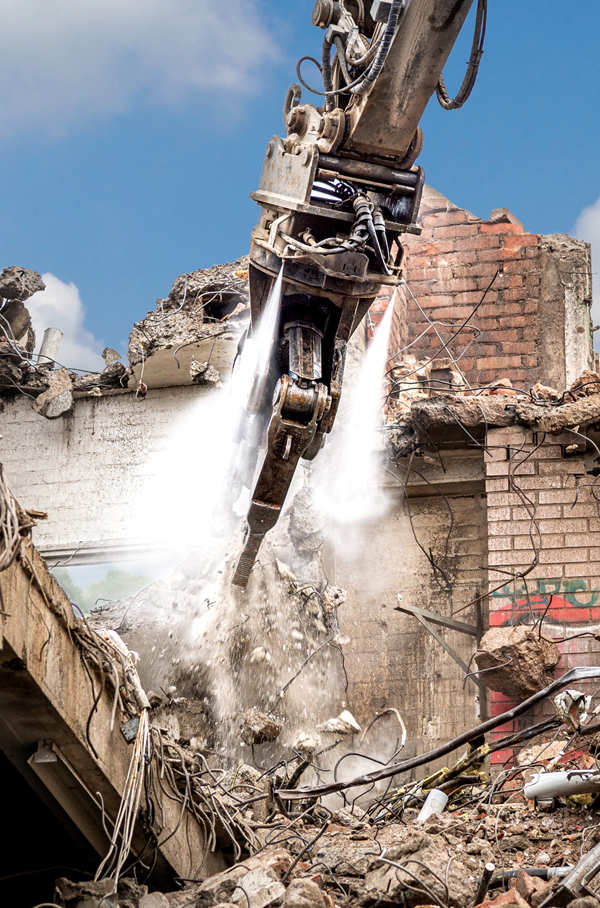
Spraystream is in effect a spraying machine that produces a mist blanket of microdroplets for dust control in open or enclosed areas. It works by agglomerating the microdroplets with the airborne particles, causing them to precipitate (air washing). The technology controls dust generated in crushing plants, demolition works, material storage or transhipment of bulk goods, or during spraying in agriculture and horticulture, in an environmentally friendly and efficient manner. It can be used for both indoor and outdoor dust control. It works as the aerodynamically shaped turbine with wind correction consists of composite material which is attached to a galvanised structure. This unit can be attached to all structures with the appropriate adapter. The vertical angle is manually adjustable from -35 to +35°.
More in the future?
The above outlines some of the developments that have occurred in equipment designed to make quarrying and construction, whether above ground or underground, indoors or outdoors, a safer and healthier place to work. There is little doubt that many of these developments are being driven by the increasing concern of companies about the welfare of workers at the sharp end of operations, with coronavirus being another spur in the development of such systems. Manufacturers are rising to the challenges being presented, and are now producing equipment and solutions which will be refined further to provide healthier, safer and cleaner working conditions.




